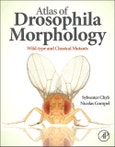The Atlas of Drosophila Morphology: Wild-type and Classical Mutants is the guide every Drosophila researcher wished they had when first learning genetic markers, and the tool they wish they had now as a handy reference in their lab research. Previously, scientists had only poor-quality images or sketches to work with, and then scattered resources online - but no single visual resource quickly at their fingertips when explaining markers to new members of the lab, or selecting flies to do their genetic crosses, or hybrids.
This alphabetized guide to Drosophila genetic markers lays flat in the lab for easy referencing. It contains high-resolution images of flies and the appropriate marker on the left side of each page and helpful information for the marker on the facing page, such as symbol, gene name, synonyms, chromosome location, brief informative description of the morphology, and comments on marker reliability. A companion website with updated information, useful links, and additional data provided by the authors complements this extremely valuable resource.
Table of Contents
Atlas of Drosophila MorphologyChyb & Gompel
Foreword
Introduction
How to Use this Book
Resources
Technical Notes
Acknowledgements
Wild-type morphology
Basics
Sexual dimorphism
Head
Head appendages
Thorax (dorsal view)
Thorax (lateral view)
Wing and haltere
Legs
Life stages: third instar larva and pupa
Pupal development
Eclosion and virgins
Bristle markers
(Bl, dm, emc, f, h, Hu, jv, M, Pin, sc, Sco, sn, Sp, ss)
Wing markers
(ci, ct, cu, Cy, D, dp, Ly, m, N, ri, Ser, ve, vg, wg, Xa)
Markers of other appendages
(al, Antp, Dll, Sc,r th, Ubx)
Eye shape markers
(B, Dfd, Dr, ey, Gl, gl, Gla, If, L, oc, ro, Roi, ru)
Eye color markers
(bw, ca, cn, g, Hn, ka, lt, Mé, p, pr, ry, se, st, v, w)
Body markers
(Bc, e, ptg, sp, Tb, y)
Summary plates
Bristle
Eye Shape
Eye Color
Wings
Balancer chromosomes
(FM6, FM7a, FM7c, FM7d, FM7i, CyO, SM1, SM5, SM6a, SM6b, T(2;3)CyO-TM9, MRS, MKRS, TM1, TM2, TM3, TM6, TM6B, TM6C, TM8, TM9, Selected multi-balancer stocks)
D. melanogaster subgroup species
Taxonomy and distribution
Phylogeny
Male epandria (external genitalia)
D. melanogaster
D. simulans
D. sechellia
D. mauritania
D. teissieri
D. erecta
D. orena
D. yakuba
D. santomea
Male external genitalia
Index






